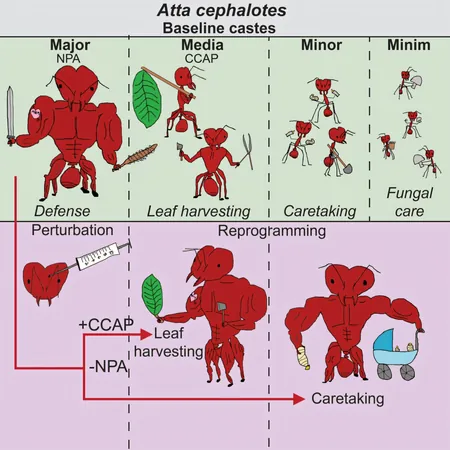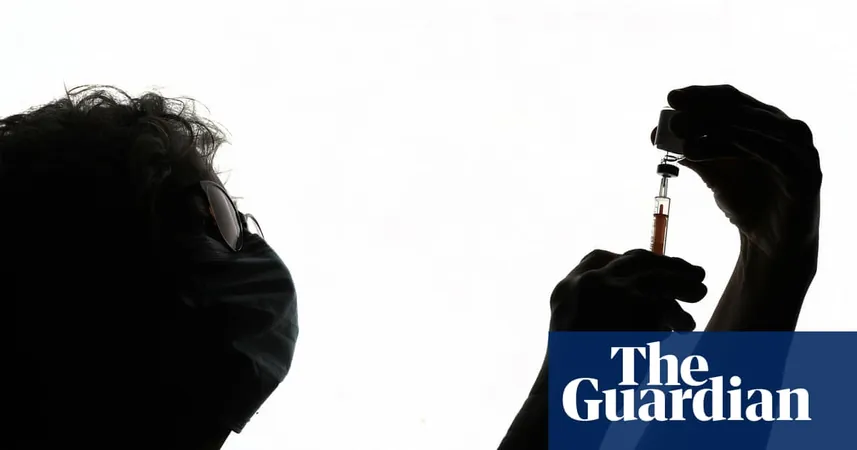
Unlocking Nature's Secrets: How Ants and Naked Mole-Rats Illuminate Our Understanding of Social Roles
2025-06-16
Author: Daniel
Introduction: Society in the Animal Kingdom
From the bustling cities that never sleep to the quiet depths of tropical forests, complex societies thrive on cooperation and distinct roles. Among the most fascinating examples are leafcutter ants, whose intricate social structure reveals the secrets of labor division in nature.
The Intriguing World of Leafcutter Ants
In the realm of Atta cephalotes, or leafcutter ants, every castes' role is meticulously defined by their physical traits. Massive Major ants stand guard, the nimble Media ants carve out leaf fragments, while the delicate Minima ants nurture the colony's fungal gardens. Each ant fulfills a purpose, showcasing an extraordinary division of labor.
Genetic Discoveries: Unraveling Ant Behavior
Leading a groundbreaking study, Shelley Berger from the University of Pennsylvania uncovered vital components of leafcutter ants' genetic makeup. Two specific signaling molecules—crustacean cardioactive peptide (CCAP) and neuroparsin-A (NPA)—play pivotal roles in determining ant behavior. Enhanced levels of CCAP promote harvesting tasks in Media ants, while elevated NPA levels curb nurturing instincts in Majors. Alterations in these molecules can effectively switch the ants' designated roles.
A Surprising Parallel: Naked Mole-Rats
The study, published in Cell, revealed an astonishing similarity between gene expression patterns in leafcutter ants and eusocial naked mole-rats. Both species exhibit an evolved system of cooperative brood care, with molecular mechanisms that could trace back over 600 million years.
Neuropeptides: The Key to Behavioral Changes
Utilizing cutting-edge 3D-printed behavioral chambers, researchers monitored ant interactions to analyze the impact of neuropeptides on task performance. By adjusting levels of CCAP and NPA, they could induce shifting roles among the ants, showcasing the profound influence of these molecules.
Evolutionary Ties Between Species
Despite naked mole-rats lacking certain neuropeptides, researchers hypothesize that the ancient gene pathways activated by their receptors could be closely linked. This connection highlights the intriguing convergence of behavioral regulations across diverse species.
The Intersection of Insulin and Behavior
Further research unveiled potential ties between neuropeptide signals and insulin regulation pathways, which play a vital role in metabolism. This surprising link raises fascinating questions about how insulin-related disorders might influence caregiving behaviors in both naked mole-rats and humans.
Exploring Lifespan and Behavioral Plasticity
Looking forward, Berger’s team is eager to investigate the essence of behavioral plasticity and its connections to lifespan. With reproductive ant queens living significantly longer than their non-reproducing counterparts, understanding these dynamics could shed light on broader biological processes.
Conclusion: Implications for Human Behavior
The remarkable findings from these studies not only advance our understanding of social roles in animals but also open new avenues for research on how similar mechanisms could apply to human behavior, particularly in relation to mental health and social interactions. As we delve deeper into the molecular underpinnings of social structures in nature, we inch closer to enlightening revelations about our own society.



 Brasil (PT)
Brasil (PT)
 Canada (EN)
Canada (EN)
 Chile (ES)
Chile (ES)
 Česko (CS)
Česko (CS)
 대한민국 (KO)
대한민국 (KO)
 España (ES)
España (ES)
 France (FR)
France (FR)
 Hong Kong (EN)
Hong Kong (EN)
 Italia (IT)
Italia (IT)
 日本 (JA)
日本 (JA)
 Magyarország (HU)
Magyarország (HU)
 Norge (NO)
Norge (NO)
 Polska (PL)
Polska (PL)
 Schweiz (DE)
Schweiz (DE)
 Singapore (EN)
Singapore (EN)
 Sverige (SV)
Sverige (SV)
 Suomi (FI)
Suomi (FI)
 Türkiye (TR)
Türkiye (TR)
 الإمارات العربية المتحدة (AR)
الإمارات العربية المتحدة (AR)